
East Turkestan or East Turkistan, also called Uyghuristan, is a loosely-defined geographical region in the northwestern part of the People's Republic of China, on the cross roads of East and Central Asia. The term was coined in the 19th century by Russian Turkologists, including Nikita Bichurin, who intended the name to replace the common Western term for the region, "Chinese Turkestan", which referred to the Tarim Basin in Southern Xinjiang or Xinjiang as a whole during the Qing dynasty. Beginning in the 17th century, Altishahr, which means "Six Cities" in Uyghur, became the Uyghur name for the Tarim Basin. Uyghurs also called the Tarim Basin "Yettishar," which means "Seven Cities," and even "Sekkizshahr", which means "Eight Cities" in Uyghur. Chinese dynasties from the Han dynasty to the Tang dynasty had called an overlapping area the "Western Regions".

Sheng Shicai was a Chinese warlord who ruled Xinjiang from 1933 to 1944. Sheng's rise to power started with a coup d'état in 1933 when he was appointed the duban of Xinjiang. The Soviet era ended in 1942, when Sheng approached the Nationalist Chinese government, but still retained much power over the province. He was dismissed from this post in 1944 and named Minister of Agriculture and Forestry. Growing animosity against him led the government to dismiss him again and appoint him to a military post. At the end of the Chinese Civil War, Sheng fled mainland China to Taiwan with the rest of the Kuomintang.

The Turkic Islamic Republic of East Turkestan (TIRET) was an independent republic centered on the city of Kashgar, located in the far west of Xinjiang Province. It is often described as the First East Turkestan Republic to differentiate it from the Second East Turkestan Republic (1944–1946).

The East Turkestan Republic (ETR) was a satellite state of the Soviet Union in northern Xinjiang that existed from 1944 to 1946. It is often described as the Second East Turkestan Republic to differentiate it from the First East Turkestan Republic (1933–1934), but "second" was never a part of its official name.

Jin Shuren was a Chinese Xinjiang clique warlord who served as Governor of Xinjiang between 1928 and 1933.
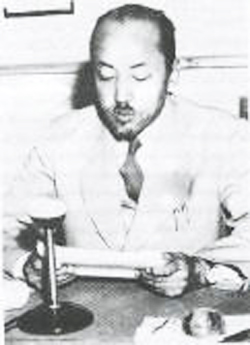
Muhammad Amin Bughra, sometimes known by his Han name Mao Deming and his Turkish name Mehmet Emin Buğra (1901–1965), was a Uyghur Muslim leader who planned to set up a sovereign state, the First East Turkestan Republic. Muhammad Amin Bughra was a Jadidist.
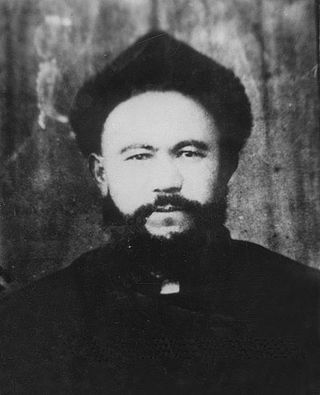
Sabit Damolla was an East Turkestan independence movement leader who led the Hotan rebellion against the Xinjiang Province government of Jin Shuren and later the Uyghur leader Khoja Niyaz. He is widely known as the first and only prime minister of the short-lived Turkic Islamic Republic of East Turkestan from November 12, 1933, until the republic's defeat in May 1934.

The East Turkestan National Army was the armed forces of the Second East Turkestan Republic (ETR). It was active from 1945 to 1949, beyond the dissolution of the ETR in 1946, when it was renamed the Ili National Army per a peace agreement between the ETR leadership and representatives of the Republic of China. It originally consisted of six regiments: the Suidun Infantry Regiment, the Ghulja Regiment, the Kensai Regiment, the Ghulja Reserve Regiment, the Kazakh Cavalry Regiment, the Dungan Regiment, the Artillery Subdivision, the Sibo Subdivision, and the Mongol Subdivision. The last two subdivisions were later reformed to regiments. All regiments were armed with mostly German-made weapons that were provided by the Soviet Union on orders by Joseph Stalin. Its personnel was trained in the Soviet Union. Rebel aviation included 42 airplanes, which were captured in the Ghulja Kuomintang air base and repaired by Soviet military personnel.

The Xinjiang clique was a military clique that ruled Xinjiang during China's warlord era. Unlike other cliques, its leaders were from outside the province.

The incorporation of Xinjiang into the People's Republic of China, known in Chinese historiography as the Peaceful Liberation of Xinjiang, was the takeover of Xinjiang by the Chinese Communist Party (CCP) and its People's Liberation Army (PLA) in the waning days of the Chinese Civil War. At the time, Xinjiang was divided into ten districts. The Republic of China controlled seven districts and governed them as Xinjiang Province, while the other three were governed by the Three Districts Economic Commission which consisted of the former leadership of the Second East Turkestan Republic.

Khoja Niyaz, also Khoja Niyaz Haji, was a Uyghur independence movement leader who led several rebellions in Xinjiang against the Kumul Khanate, the Chinese governor Jin Shuren and later the Hui warlord Ma Zhongying. He is best remembered as the first and only president of the short-lived Islamic Republic of Eastern Turkestan from November 1933 until the republic's defeat in April 1934.
The Soviet invasion of Xinjiang was a military campaign of the Soviet Union in the Chinese northwestern region of Xinjiang in 1934. White Russian forces assisted the Soviet Red Army.
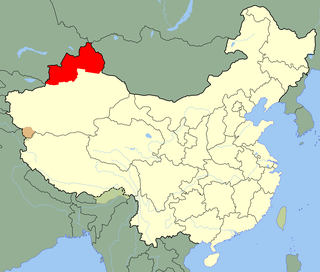
The Ili Rebellion was a separatist uprising by the Turkic peoples of northern Xinjiang against the Kuomintang government of the Republic of China, from 1944 to 1946. The Ili Rebellion began with the East Turkestan National Revolution, known in Chinese historiography as the Three Districts Revolution, which saw the establishment of the Second East Turkestan Republic. The leadership was dominated by Uyghurs but the population consisted mostly of Kazakhs.

Yulbars Khan, courtesy name Jingfu (景福), was a Uyghur chieftain and Kuomintang general during the Chinese Civil War. He entered the service in the Kumul Khanate of Muhammad Khan of Kumul and later his son Maksud Shah. He served as an advisor at the court, until when Maksud died in March 1930, governor Jin Shuren abolished the khanate. Yulbars then conspired with Khoja Niyaz and Ma Zhongying to overthrow Jin in the Kumul Rebellion. According to some people, Ma restrained Yulbars from traveling to Nanking to ask the Kuomintang for help, Ma earlier had an agreement with the Kuomintang that if he seized Xinjiang, he would be recognized by the Kuomintang as its leader.

In 1937 an Islamic rebellion began in southern Xinjiang. The rebels were 1,500 Uighur Muslims commanded by Kichik Akhund, who was tacitly aided by the New 36th Division, against the pro-Soviet provincial forces of the puppet Sheng Shicai.

The Kumul Rebellion was a rebellion of Kumulik Uyghurs from 1931 to 1934 who conspired with Hui Chinese Muslim General Ma Zhongying to overthrow Jin Shuren, governor of Xinjiang. The Kumul Uyghurs were loyalists of the Kumul Khanate and wanted to restore the heir to the Khanate and overthrow Jin. The Kuomintang wanted Jin removed because of his ties to the Soviet Union, so it approved of the operation while pretending to acknowledge Jin as governor. The rebellion then catapulted into large-scale fighting as Khotanlik Uyghur rebels in southern Xinjiang started a separate rebellion for independence in collusion with Kirghiz rebels. The various groups of rebels were not united. The main part of the war was waged by Ma Zhongying against the Xinjiang government. He was supported by Chiang Kai-shek, the Premier of China, who secretly agreed to let Ma seize Xinjiang.
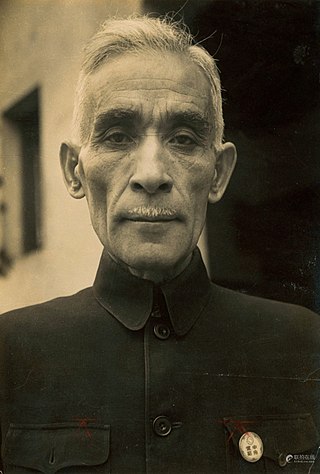
Masud Sabri, also known as Masʿūd Ṣabrī, was an ethnic Uyghur politician of the Republic of China who served as the governor of Xinjiang during the Ili Rebellion. He received education at Kulja and Istanbul and was a Pan-Turkist. Chiang Kai-shek appointed him the first Uyghur governor of Xinjiang.
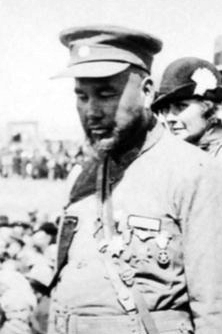
Mahmut Muhiti, nicknamed Shizhang, was a Uyghur warrior from Xinjiang. He was a commander of the insurgents led by Khoja Niyaz during the Kumul Rebellion against the Xinjiang provincial authorities. After Hoya-Niyaz and Sheng Shicai, the newly appointed ruler of Xinjiang, formed peace, Muhiti was briefly appointed by Sheng a Military Commander of the Kashgar region in 1934, but was soon demoted and appointed commander of the 6th Division, composed of Turkic Muslims and named Deputy Military Commander of the Kashgar region. Muhiti opposed Sheng's close ties with the Soviet Union forming opposition to his regime in Kashgar. He organised the Islamic rebellion against Sheng in 1937 and fled to British India. Muhiti was afterwards active in the Japanese-occupied China, fruitlessly cooperating with Japan in order to enhance the cooperation between Japan and Muslims, dying in Beijing.

Ishaq Beg Munonov, also Isḥāq Beg, was an ethnic Kyrgyz leader in Xinjiang, China during the first half of the 20th century.

The Coalition Government of Xinjiang Province was the governing body of China's Xinjiang Province from 1946 to 1947. It was formed after a Soviet-brokered peace agreement between the Republic of China (ROC) and the breakaway Second East Turkestan Republic (ETR). The dissolution of the ETR coincided with the establishment of the coalition government; however, the interests of the ETR's former leaders were retained through the subordinate Ili District Council. The coalition government collapsed after the withdrawal of the former ETR side, which opposed the appointment of Masud Sabri, a pro-Kuomintang conservative, as the provincial chairman. Despite himself being a Turkic Uyghur, Sabri undid the pro-Turkic reforms implemented by his predecessor Zhang Zhizhong.































